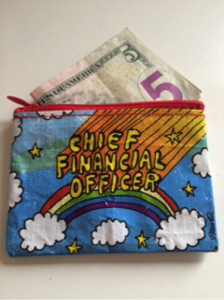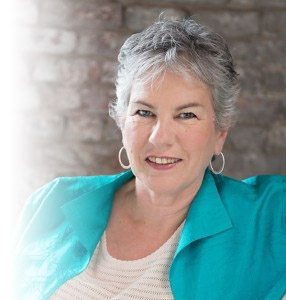
I love my clients. They are amazing, heart-centered entrepreneurs who want to use business as a tool to do good in the world.
My client Jack Kinley of Lab Monkey Communications and I were recently wrapping up our year of working together. As his CFO for the past 12 months, we successfully built financial systems and structures for his business that significantly increased his bottom line through accounting and strategic planning.
Jack sent me a little gift. It’s a colorful coin purse emblazoned with the words “Chief Financial Officer” across the front. Inside the card he wrote: “Hope it overflows with money, laughter, and happiness.”
It doesn’t get much better than that.
The coin purse is just the right size for my business cards, so I put some in it and put it in the pocket of my walking pants. (I’ve learned to never go anywhere without my business cards, ‘cause your never know who you’re going to meet or where.)
One day as I was walking a thought occurred to me—from wherever it is that thoughts are born—that it might be a good idea to also stash a credit card and some cash in my little coin purse. However, I didn’t follow up on the idea because I just plain didn’t remember it once I got home.
And then a remarkable thing happened. As I walked along the trail in the middle of marshland, there, right in front of me on the path was a $5 bill.
I picked it up, looked around to see who might have dropped it, but there was no one in sight. I gave thanks for the unexpected income and continued to walk. About 20 feet on, there was another $5 bill. Wow!
That coin purse is a container. Building containers is a powerful way to manifest your dreams and intentions. A container provides a place for your intentions to manifest. It attracts your dreams and gives them a form to take up residence in.
I believe plans are also containers. Creating a plan for your business allows you to get really clear on your vision and intentions so you can provide a structure for them to fill in and inhabit.
The planning process can take one of two forms: Design Gates or Sprint-and-Scrum.
Design Gates, also called stage gates, are the traditional approach. They call for spending hours and hours planning the whole project from A to Z. Then implementing a written plan by moving from one stage to the next in order.
The Design Gates process is mechanical, and doesn’t allow much room for feedback or revisions. An example of a Design Gates plan would be a 26-page business plan that outlines your 5-year plan, complete with projections and budgets.
The Sprint-and-Scrum approach is much more nimble. It involves coming up with an idea, brainstorming action plans (the scrum part), then putting the ideas into action and watching what happens (the sprint part).
Then, you add another scrum to tweak the plan, and then off to another sprint. This is an iterative process that allows for rapid design evolution and revision. A business plan that employs this format would look at the next 90 days, rather than the next 60 months. This method is particularly useful in industries that experience rapid change.
Both of these approaches have their place in business plans: When you look for bank loan or a line of credit, for example, the traditional business plan based on Design Gates fits the bill. Not because it’s the better plan, but because it’s what traditional bankers are used to. It’s important to always consider your audience and what they are comfortable with, especially if you want something from them.
The bootstrapping start-up would likely find more benefit from the Sprint-and-Scrum approach when they create plans because they are scrambling to learn quickly what works and what doesn’t.
What planning approach do you use in your business right now? I would love to hear from you. Post a question or thought in the comments below.

This really made me thinking. My current approach is Sprint-and-Scrum. I’m an executive coach in my third year of business now and the business is evolving day by day. I find it difficult to set a concrete business plan. Things constantly change. I do realize that I don’t have a clear vision of where I want my business to be in 5 years. I think I might start from there. Thank you for the wonderful post, Monique!
You’re so welcome, Nozomi. At your stage of business, where you don’t see much farther than 3-6 months, the SandS approach works well for you. Tweak as you go along.
This is a great story, and a great lesson, Monique! I love the container idea – that makes such good sense to me. I, too, would be in the SandS category, but I’m fine with that. I have a counseling practice that is long standing and well established. But, I also have a coaching practice that is in start up. So, different energies and awarenesses go with each. The traditional plan definitely doesn’t fit me at this point. 🙂
This is a great post – can’t wait to read more!
Hi Wendy,
Thanks so much for stopping by. The traditional plan may never fit you! And that’s OK…it all depends on having the right tool for the right job.